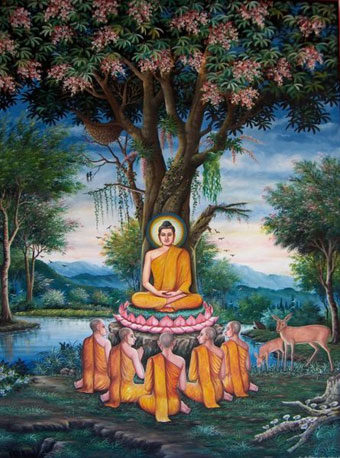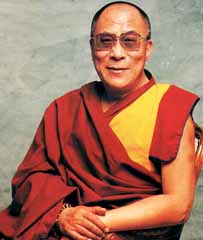Buddhism
I take refuge in the Buddha.
I take refuge in the doctrine.
I take refuge in the monastic order.
- Traditional and Liturgical

Introduction
Buddhism is probably the most simple religion to describe in broad generality though it often is practiced with a modicum of cultural flair. Buddhism’s chief tenets, called the Four Noble Truths, are:
- Suffering exists.
- Suffering has a cause, namely, desire.
- Desire is the only cause of suffering.
- There is a way to end desire.
That is the core of Buddhism; and one need only accept these statements to be a Buddhist. However, Buddhist practice also has specific traditions about applying these statements to real life. An elaboration on the fourth Noble Truth is the below Eightfold Path, which is a series of steps for Buddhist adherents to follow in order. Buddhists should attain these:
- Right views.
- Right intention.
- Right speech.
- Right conduct.
- Right livelihood.
- Right strivings.
- Right mindset.
- Right concentration.
The different ways in which the fourth Noble Truth is sought can define different religions. If one uses the Eightfold Path to attempt to achieve the fourth Noble Truth, then one uses Buddhist tradition.
History
 The term “Buddha” comes from a Sanskrit word meaning “enlightened,” “knowing,” or “awake.” In Buddhism
it is used as a title for anyone who has achieved enlightenment.
The term “Buddha” comes from a Sanskrit word meaning “enlightened,” “knowing,” or “awake.” In Buddhism
it is used as a title for anyone who has achieved enlightenment.
The historical person called Buddha was Siddhartha Gautama, a prince born around 560 BCE in the northern part of the Indian subcontinent. His parents’ wealth shielded him from all grief until his manhood, at which point he decided to explore places away from his luxurious upbringing.
For the first time in his life, he saw and learned of old age, disease, and death. He become horrified with the realization of the human condition, but then he saw an ascetic (monk) who was satisfied. He left his royal lifestyle and pursued the end to suffering; when he achieved this end, he taught the path he learned as the Buddha.
Spirituality
Buddhism as a faith tradition does not necessarily incorporate teachings about spirituality; however, various cultures often apply their own understandings about spirituality to Buddhism.
Some traditions teach that the aim of Buddhism is the actualization of nirvana, which is a form of enlightenment which is distinctly spiritual as well as earthly. Nirvana is neither nihilistic nor inclusive of all knowledge; it is a state associated with righteousness through moderation. Those who have achieved nirvana are free from samsara, or the cycle of death and rebirth.
Authority
Buddhism has no central authority but practitioners often adopt their culture’s mores to interpret the faith.
 The Dalai Lama - Tenzin Gyatso - also known as "His Holiness the Dalai Lama", a Tibetan Buddhist, is the
internationally renowned figurehead of the Tibetan Buddhist faith and is the spiritual, but not
specifically religious leader throughout the world of buddhism. He is only, in his own words, “a simple
monk.” The Dalai Lama is the
recipient of Nobel Peace Prize, among many other recognitions for his life-long work inpromoting peace
throughout the world.
The Dalai Lama - Tenzin Gyatso - also known as "His Holiness the Dalai Lama", a Tibetan Buddhist, is the
internationally renowned figurehead of the Tibetan Buddhist faith and is the spiritual, but not
specifically religious leader throughout the world of buddhism. He is only, in his own words, “a simple
monk.” The Dalai Lama is the
recipient of Nobel Peace Prize, among many other recognitions for his life-long work inpromoting peace
throughout the world.
Additional Reading
The ULC catalog carries The Art of Happiness: The Art of Living, a guide on how to defeat day-to-day depression, anxiety, anger, jealousy, or just an ordinary bad mood written by His Holiness the Dalai Lama.

